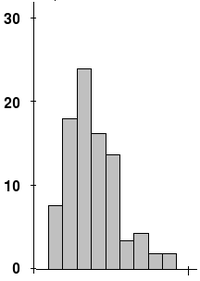Skewness

So imagine you have a toy car and you want to see how it moves on different surfaces. You try it on a smooth surface and it rolls straight ahead. You try it on a bumpy surface and it wobbles to one side.
Skewness is like the wobbling of the toy car. It tells you if something is leaning more to one side or another. In statistics, we use skewness to describe how the numbers in a set are spread out.
If the numbers in a set are evenly spread out, they are called symmetrical. This means the numbers are the same on both sides of the middle point. If you have a set of numbers that are not the same on both sides of the middle point, they are called skewed.
There are two types of skewness: positive and negative. Positive skewness means that most of the numbers are on the left side of the middle point, and there are only a few numbers on the right side. Negative skewness means that most of the numbers are on the right side of the middle point, and there are only a few numbers on the left side.
For example, if you have a set of numbers that represents the ages of people in a group and most of the people are younger than 30, but there are a few people who are much older, then the set is positively skewed. If most of the people are older than 50, but there are a few younger people, then the set is negatively skewed.
So skewness helps us understand how the numbers are spread out and whether they are more on one side or another, just like how the toy car wobbles more to one side on a bumpy surface.
Skewness is like the wobbling of the toy car. It tells you if something is leaning more to one side or another. In statistics, we use skewness to describe how the numbers in a set are spread out.
If the numbers in a set are evenly spread out, they are called symmetrical. This means the numbers are the same on both sides of the middle point. If you have a set of numbers that are not the same on both sides of the middle point, they are called skewed.
There are two types of skewness: positive and negative. Positive skewness means that most of the numbers are on the left side of the middle point, and there are only a few numbers on the right side. Negative skewness means that most of the numbers are on the right side of the middle point, and there are only a few numbers on the left side.
For example, if you have a set of numbers that represents the ages of people in a group and most of the people are younger than 30, but there are a few people who are much older, then the set is positively skewed. If most of the people are older than 50, but there are a few younger people, then the set is negatively skewed.
So skewness helps us understand how the numbers are spread out and whether they are more on one side or another, just like how the toy car wobbles more to one side on a bumpy surface.
Related topics others have asked about:
